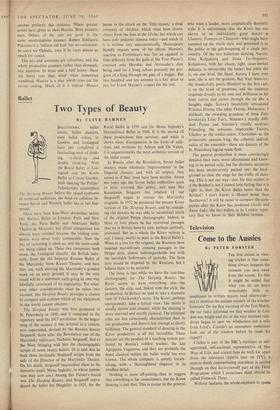Ballet
Two Types of Beauty
By CLIVE BARNES
BALLETGOERS, ballet lovers, ballet dancers, even ballet critics, in London and Leningrad have just completed a fascinating week of think- There have been East-West skirmishes before (the Bolshoi Ballet in London, Paris and New York. the Paris Ballet and Amtrican Ballet theatre iii Moscow), but direct comparison has always been avoided because the visiting com- panies were never truly comparable. Now the day of reckoning is upon us, and the score-cards are being added up. These two companies both arose, the Leningrad directly, the British indir- ectly, from the old Imperial Russian Ballet of the Maryinsky (now Kirov) Theatre; and here they are, each dancing the Maryinsky's greatest work on an away ground. It may be the only result will be a stalemate, each going its own way blissfully convinced of its superiority. Yet what- ever other considerations must be taken into account, this Sleeping Beauty provides a chance to compare and contrast which all the whitewash in the world cannot obscure.
The Sleeping Beauty was first produced in St. Petersburg in 1890, and it remained in the repertory until the 1917 revolution. At the begin- ning of the century it was notated in a system, now superseded, devised by the Russian dancer Stepanoff. Soon after the Revolution one of the Maryinsky regisseurs, Nicholas Sergueeff, fled to the West, bringing with him the choreographic scripts of some twenty ballets. (It is said that he took these invaluable Stepanoff scripts from the safe of the Director of the Maryinsky Theatre. On his death, Sergueeff bequeathed them to his favourite pupil, Mona Inglesby, in whose posses- sion they now are.) Among this Fafner's hoard was The Sleeping Beauty, and Sergueeff repro- duced the ballet for Diaghilev in 1921, for the Royal Ballet in 1?39 and for Mona Inglesby's International Ballet in 1948. It is the second of these productions that survives; and while it shows many discrepancies in the form of addi- tions and revisions by Ashton and De Valois, it is unquestionably the most authentic version of the ballet extant.
In Russia,. after the Revolution, Soviet ballet masters made wholesale 'improvements' in the Imperial classics; and, with all respect, they sound as if they must have been terrible. About ten years ago the Soviet ballet authorities seem to have reversed this policy, and men like Konstantin Sergeyev (no relation of our Sergueeff) began to restore the Maryinsky originals. In 1952 he produced the present Kirov version of The Sleeping Beauty, and by consult- ing old dancers he was able to reconstruct much of the original Petipa choreography. Indeed, in three or four places he has recovered passages that we in Britain have by now, perhaps unwisely, jettisoned. But as a whole the Kirov version is not, I fancy, nearly so pure as the Royal Ballet's. When at a loss for the original, the Russians have inserted marvellously cunning passages in the Petipa style, almost indistinguishable but with the inevitable hollowness of pastiche. The facts here would be disputed by the Russians, but I believe them to be accurate The irony is that while we have the true-blue choreography for The Sleeping Beauty, the Kirov seems to have everything else—the dancers, the style and, linked with the style, the production. In Britain we tend to take a dramatic view of Tchaikovsky's score. The Kirov, perhaps unexpectedly, take a lyrical view. The music is usually slower and sweeter, while the dancing is more reserved and strictly classical. The principal roles are less consciously characterised than in our production, and there is less attempt at showy brilliance. The general standard of dancing in the Kirov production is all but incredible. These dancers are the product of a teaching system per- fected by Russia's noblest teacher, the late Agrippina Vaganova, and they are probably the finest classical stylists the ballet world has ever known. The whole company is quietly breath- taking, with a thoroughbred elegance in its smallest detail.
Nothing is more off-putting, than to suggest that something is for connoisseurs, but the Kirov dancing is just that. This is caviar to the general, who want a louder, more emphatically dramatic style. It is unfortunate that the Kirov has not shown us an individually great dancer—a Ulanova, Fonteyn or Chauvire—who might have summed up the whole style and presented it to the public in the gift-wrapping of a single per- sonality. Of the two ballerinas dancing Aurora, Irina Kolpakova and Zenia Ter-Stepanov, Kolpakova, with her chaste, light, clean-limbed delicacy, is measurably the better; but while she is, on one level, the finest Aurora I have ever seen, she is not the greatest. But Yuri Soloviev, the wonderfully poetic Bluebird in the first cast, is on the brink of greatness, and the audience responds directly to his ease and brilliance as his body curves and carves through the air like a haughty eagle. Sizova's beautifully articulated Princess Florine (the other Florine, Moiseyeva, I disliked), the sweeping grandeur of Inns Zub- kovskaya's Lilac Fairy, Semenov's royally diffi- dent Prince and Sokolov's royally sardonic Princeling, the sensuous, impeccable Fairies, Vikulov as the soldier-suitor, Chernishev as the aristocratic peasant king, the cohesive individ- uality of the ensemble—these are dancers of the St. Petersburg legend made flesh.
The general production is more convincingly detailed than ours, more affectionate and know- ing in its period style, but the dramatic narrative has been unobtrusively pushed into the back- ground to clear the stage for the traffic of danc- ing. This is not our way—nor, for that matter, is it the Bolshoi's; but I cannot help feeling that it is right. Is, then, the Kirov Ballet better than the Bolshoi? I don't know; is Mozart better than Beethoven? It will be easier to compare the com- panies after the Kirov has produced Giselle and Swan Lake, the two ballets in its London reper- tory that we know in their Bolshoi version.


































 Previous page
Previous page